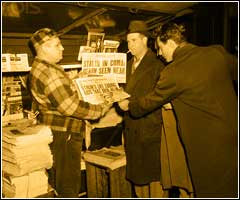History of Olympic Weightlifting
Site Sponsors
 The Lift Up project is brought to you by chidlovski.com.
The Lift Up project is brought to you by chidlovski.com.
Olympic Legends @ Lift Up
Lift Up Site Search
Home ›› Feature Articles ››
Feature Articles @Lift Up

Without Moving a Muscle
Time Magazine, Friday, Jan. 31, 1964
The symptoms are turning up everywhere. A commuter puts down his paper and his eyes glaze as if with some interior rapture; a stenographer stops typing and stiffens in her chair; waiting for the children's hamburgers to brown, a housewife suddenly presses her hands on the kitchen table until the knuckles show white. These are not the victims of some new virus, nor has the strain of modern living sent them around the bend. Instead, they are practicing the very latest wrinkle in body culture: isometrics.
Miracle from a Frog's Leg. The basic principle of isometric exercise was discovered back in the '20s, when scientists found that when one leg of a frog was tied down over a period of time, it grew significantly stronger than the leg left free. But it was not until 1953 that two German doctors worked out the implications of this experiment and applied them to the human body.
Traditional exercise, known as "isotonic," beefs up a muscle by moving it. Isometric exercise, on the other hand, does not move the muscle at all; the exercises are all performed against an immovable object. By this immobile contraction, its adherents claim, nearly 100% of the muscle's thousands of hairlike fibers are stimulated-as compared with the mere 50% to 60% involved in isotonic exercise.
Athletes use a variety of bars, braces and frames that can be adjusted to just the right inch or angle to strengthen a muscle for a particular job (one high jumper successfully trained by straining against a device that held his take-off leg at the exact angle from which it started its spring). The Green Bay Packers were one of the first major pro football teams to adopt isometrics, and some credit the exercises for their brilliant seasons in 1961 and 1962, after which other teams caught on-and caught up. "It's the greatest thing the world has ever seen," rhapsodizes Olympics Weight-Lifting Coach Bob Hoffman. "I am absolutely awestruck at the miracles it has wrought." A millionaire manufacturer of gym equipment, Hoffman claims that he was the first to make isometric exercising devices. He has seen about 50 competing firms climb on the bandwagon just within the past four years.
No Sweat. But ordinary laymen need no equipment at all-and precious little time. They may even resculpture their bodies while doing something else without attracting undue attention. To take one inch to three inches off the paunch in a mere month: 1) inhale deeply, pushing out the abdomen as far as possible and holding it there one second; 2) exhale, pull the abdomen in as far as it will go and hold it there for six seconds; 3) repeat six times a day in any position.
Executives can build up their biceps when their secretaries aren't looking simply by sitting up straight, sliding their open palms against the underside of their desks, and pushing up for six seconds. They can reripple their arm, chest and shoulder muscles by giving six-second pushes of one fist into the other hand. Their wives can firm up their thighs by standing with feet spraddled widely and trying to pull their thighs toward each other with maximum tension for six seconds, three times a day.
Isometrics do nothing to improve anyone's dexterity, coordination or stamina, and will never result in acquiring a tan. But they do provide more strength faster than anything else. Their no-sweat convenience and brevity, plus their adaptability to anybody's problem area, has already spawned a clutch of manuals on the subject and a menu of exercises as long as an unflexed arm. The U.S. Navy has endorsed the exercises, and its magazine, All Hands, has published a series of nine isometrics that it calls "ideal for Navymen whose duties on location restrict their ability to engage in athletics."
Back to Feature Articles
